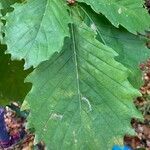Trees to 25 m tall, deciduous. Branchlets strong, sulcate, densely yellowish gray stellate tomentose. Petiole 2-5 mm, densely brown tomentose; leaf blade obovate to narrowly so, 10-30 × 6-30 cm, abaxially densely grayish brown stellate tomentose, adaxially dark green and pubescent but glabrescent, base rounded, margin with a few undulate to rough serrations on each side, apex with short, blunt tip; secondary veins 4-10 on each side of midvein; tertiary veins abaxially prominent. Female inflorescences axillary on apical part of young shoot, 1-3 cm. Cupule cupular, 1.2-2 × 2-5 cm including bracts, enclosing 1/2-2/3 of nut; bracts reddish brown, narrowly lanceolate, ca. 1 cm, inflexed or erect, leathery, abaxially with brown filiform hairs, adaxially glabrous. Nut ovoid to broadly so, 1.5-2.3 × 1.2-1.5 cm, glabrous; scar ca. 1 cm in diam., slightly raised; stylopodium ca. 2 mm in diam. Fl. Apr-May, fr. Sep-Oct.
More
A tree. It grows about 7-25 m tall. It loses its leaves during the year. The small branches have a yellow covering. The leaf stalk is 2-5 mm long. The leaf blade is oval and 10-30 cm long by 6-30 cm wide. The edges have a few wavy or rough teeth. There are 4-10 secondary veins on each side of the mid vein. The female flower is in the axils of leaves near the ends of young branches. They are 1-3 cm long. The cup is 1.2-2 cm long by 2-5 cm wide including the bracts. The nut is oval and 1.5-2.3 cm long by 1.2-1.5 cm wide.


